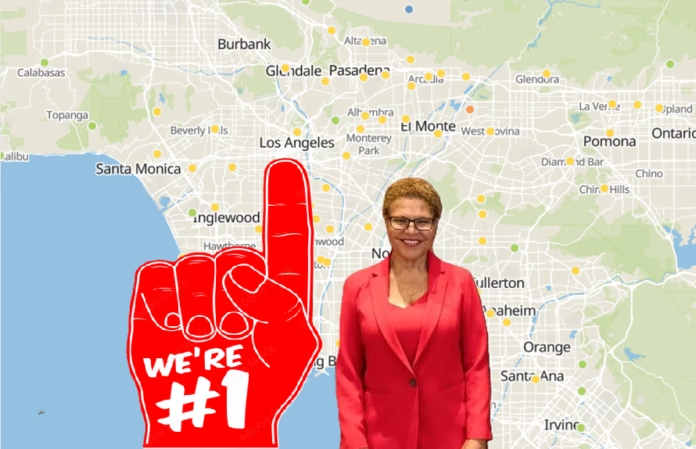Global Report Finds Africa and South Asia Far Worse, But In U.S., LA Stands Alone
Los Angeles is the most polluted major city in the U.S., according to a new report from IQAir, which measures PM2.5 — fine particulate matter — from over 40,000 monitoring stations across 8,954 locations in 138 countries, territories and regions worldwide. And our regional air basin accounts for almost half the 100 most polluted cities in the U.S. The ports of Los Angeles and Long Beach are the largest stationary sources of pollution in the region, and the transportation routes emanating from them are the primary mobile sources, reaching well into the Inland Empire.
The World Health Organization PM2.5 guideline of 5 micrograms per cubic meter (μg/m3) as an annual average was only met by 17% of global cities, while 126 (91.3%) out of 138 countries and regions exceeded it. It’s a stark reminder that the climate crisis isn’t the only threat to human life from the fossil fuel industry, which falls primarily on the global South.
Yet, this is actually a significant improvement from 9% of cities meeting the guideline in IQAir’s report last year. Regionally, 56.9% of cities in Oceania (Australia, New Zealand, and French Polynesia) met the guideline — setting an example of what is possible. In North America, second best, it was 29.3%. It was 8.0% in Europe, and 7.8% in Latin America and the Caribbean, but was 0-1% in the rest of the world’s regions — all of Africa and Asia.
“IQAir has provided a real contribution by publishing this integrated worldwide perspective on particle burdens – which is a critical marker for environmental and public health,” said Ed Avol, professor emeritus at USC School of Medicine. “One of the most significant accomplishments of the report is to draw attention to continuing and widening exposure disparities in various regions of the world,” he added. “The data reflect not only the disparities that exist between nations and continents but also the potential for real improvement (as seen among those countries that have enforced emissions reduction efforts).”
Although it’s only one component of air pollution, PM2.5 had a dominant health impact. As the report notes, “In 2021 alone, 8.1 million total deaths were attributable to air pollution, with 58% of those deaths caused by ambient PM2.5 air pollution.”
LA averaged 10.1 (more than twice the guideline) compared to 8.8 to 7.7 for the next nine major cities, four of which were in Texas. In addition, all five of the most polluted cities in North America were in the South Coast air basin, topped by Ontario at 14.3, although an expert cautioned Random Lengths the data could be skewed due to monitoring locations. Of the 100 most polluted municipalities in the U.S., 60 were in California, and 45 were in the regional air basin: 33 in LA County, 5 in San Bernardino, 4 in Orange and 3 in Riverside. This contrasts sharply with the fact that 43% of the 863 locales in California met the standard, including cities like San Francisco, Oakland, Alameda and San Jose.
This is consistent with previous findings from the South Coast Air Quality Management District. “Local air regulators tell us that, on average, more than 1,000 people in the Los Angeles region will die prematurely each year between 2025 and 2037 because of exposure to PM2.5 that exceeds federal standards,” former AQMD Boardmember Joe Lyou told Random Lengths. He directed attention to a 2022 chart projecting 1,168 annual deaths from PM2.5 along with 341 due to ozone.
There was no breakdown for LA city neighborhoods, but Compton (11.9), West Rancho Dominguez (11.9), Gardena (11.8), Carson (11.2) and Signal Hill (10.6) were all in the top 100. Long Beach (9.8) was slightly lower, while Manhattan Beach, Rolling Hills and Palos Verdes Peninsula all registered 7.7.
As the report explains, the data from individual monitoring locations is “organized into ‘settlements,’ indicating cities, towns, villages, counties, or municipalities, reflecting local population distributions and administrative divisions,” but the report itself refers to all settlements as cities. IQAir sells low-cost air quality monitors to non-governmental organizations, or NGOs, and has an initiative, Schools4Earth, that seeks to provide over 1 million schools with air quality monitors. Children are especially vulnerable to pollution’s health impacts due to their higher respiratory and metabolic rate, and monitors located in schools generally capture the conditions for entire populations. This could lead to long term health complications like asthma or cancer. But presently, IQAir estimates only 21% of the global population has such monitoring. Consequently, country and regional totals are calculated as population-weighted averages based on city-level data. And here the global picture is striking.
The Global Picture
Chad (91.8) is the world’s most polluted country, “influenced by the Bodélé Depression, one of the largest global sources of atmospheric dust,” in contrast to fossil fuel pollution’s dominant role worldwide. The Indian subcontinent — India (50.6), Pakistan (73.7), and Bangladesh (78.0) is the most polluted geographical sub-region, with three of the five most polluted countries, while nearby Tajikistan (46.3) ranks #6 and adjacent Nepal (42.8) ranks #7.
The other top-five country, D.R. Congo (58.3), is part of another highly-polluted regional cluster, along with Uganda (41.0), Rwanda (40.8) and Burundi (40.3), which ranks 8-10.
On the city level, Karaganda, Kazakhstan (104.8) ranks #3 and N’Djamena, Chad (91.8) ranks #8, and Hotan, China (84.5) ranks #17. Aside from them, all of the 40 most-polluted cities are either in India (27), Pakistan (8) or Bangladesh (2). More broadly, India has 74 of the 100 most-polluted cities.
The wider Central and South Asia region “continues to experience some of the worst air pollution in the world” as “Nearly one-third of cities recorded annual PM2.5 concentrations exceeding ten times the WHO guideline, posing a severe health risk to millions.” The region’s urban centers are relatively well-monitored, however, “many areas in India remain under-monitored, particularly in smaller cities and rural regions.”
In contrast, “Africa’s air quality in 2024 remains a major public health crisis,” exacerbated by “rapid urbanization, population growth, and limited air quality monitoring.” Specifically, “With just 400 monitoring stations — only 0.6% of the global total — significant data gaps persist, most notably in Lagos, Africa’s second most populous city, which was absent from the report due to insufficient data.” Monitoring is expanding, but there’s a long way to go. “The number of reporting cities grew from 79 in 2023 to 106 in 2024, yet only 24 of Africa’s 54 countries had cities that met data inclusion requirements.” And more monitoring reveals even more pollution: Kinshasa, Africa’s most populous city, was the second most polluted at 58.2 μg/m³, “a 40% increase from the previous year, partly due to expanded data availability.”
“As with any effort, there are some technical issues of potential concern worth exploring; these include distribution of instrumentation, deployment and specific criteria for instrument installation, maintenance, proportional weighting, and/or corrections for integration of regulatory monitoring data with the larger set of low-cost citizen-operated units,” Avol said.
“However, the summary visualizations and tabular rankings will hopefully motivate interest and discussion, which sets the stage for future improvements in understanding and emissions reduction … and for that, IQ Air has provided a substantial public service.”



